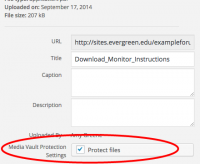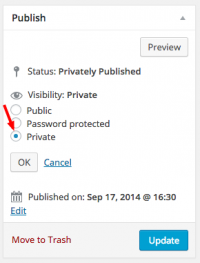Difference between revisions of "WordPress Tutorial for sites.evergreen.edu"
From Help Wiki
| Line 100: | Line 100: | ||
}} | }} | ||
===Site Accessibility and Protection=== | ===Site Accessibility and Protection=== | ||
| − | + | ====Who Has Access to Your Site==== | |
*With WordPress, you have several options for controlling who can see your site or portions of your site. | *With WordPress, you have several options for controlling who can see your site or portions of your site. | ||
}} | }} | ||
Revision as of 17:13, 14 October 2016
Site Visibility
- Settings are located in Settings > Reading. Options include:
- Publicly viewable and indexed by search engines
- Publicly viewable but requesting search engines to not index your site
- Requires a login (must be an Evergreen community member)
- Requires a login and must be a subscriber of the site (this is the option we use to limit access to enrolled students only)
- Only admins of the site
Making your site visible
- New sites by default are set to not be publicly viewable with the idea that faculty must time to work on the site before it becomes public.
- To change your site’s visibility got to Settings > Reading
- Either of the top two options will open the site to visitors. Other options require an Evergreen login and varying levels of access to the site.
Enrollment
- At the beginning of the quarter, enrolled students will be added as subscribers to the site
- Additionally, faculty can add/remove users via Users > Add New
Users and Roles
- Users added to your site can be assigned a variety of roles with different abilities.
- Subscribers can view content but cannot create regular site content. This is the default role students are assigned when added to your course.
- Contributors can write and manage their posts but not publish posts or upload media files.
- Authors can publish and manage their own posts, and are able to upload files.
- Editors can publish posts, manage posts as well as manage other people’s posts, etc.
- Administrators have access to all the administration features.
Protected Files and Pages/Posts
File protection
- Faculty can limit access to enrolled students for uploaded media files that must copyrighted protection.
- Once a file has been uploaded to the Media Library you can edit items that should be protected by clicking Add to Protected under the Media Vault Protection Settings.
- Choose "Use Default Setting" for file access permission (which is set to subscribers).
- See Protected Files for more info and troubleshooting tips.
Page/post privacy
- Choose which portions of your site are public and which are only viewable to your students.
- By setting a page’s visibility to "Private" (in the Publish block) it will only be viewable to logged in users who are subscribers to the site (your students).
- Note: you should still use file protection for media that needs protection even if it is only linked from a private page.
Additional Features
Email enrolled students from within WordPress
- Using the Email Users plugin to contact all registered students in your program
Discussion Forums
- Protected Discussion Forums
Evaluation Conference Sign-up Sheets
- Using the Eval Conference Sign-up Sheet plugin to create a page where students can easily sign-up for a conference time slot.
|
Contents
}}


